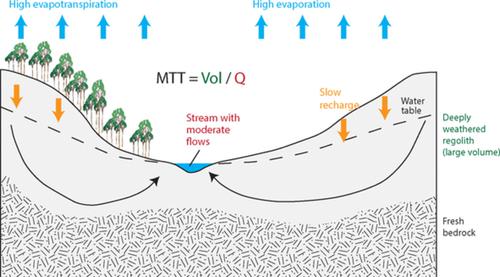当前位置:
X-MOL 学术
›
Hydrol. Process.
›
论文详情
Our official English website, www.x-mol.net, welcomes your
feedback! (Note: you will need to create a separate account there.)
The variation and controls of mean transit times in Australian headwater catchments
Hydrological Processes ( IF 2.8 ) Pub Date : 2020-08-03 , DOI: 10.1002/hyp.13862 Ian Cartwright 1 , Uwe Morgenstern 2 , William Howcroft 3 , Harald Hofmann 4 , Robin Armit 1 , Michael Stewart 2 , Chad Burton 5 , Dylan Irvine 6
Hydrological Processes ( IF 2.8 ) Pub Date : 2020-08-03 , DOI: 10.1002/hyp.13862 Ian Cartwright 1 , Uwe Morgenstern 2 , William Howcroft 3 , Harald Hofmann 4 , Robin Armit 1 , Michael Stewart 2 , Chad Burton 5 , Dylan Irvine 6
Affiliation

|
Determining mean transit times in headwater catchments is critical for understanding catchment functioning and understanding their responses to changes in landuse or climate. Determining whether mean transit times (MTTs) correlate with drainage density, slope angle, area, or land cover permits a better understanding of the controls on water flow through catchments and allows first-order predictions of MTTs in other catchments to be made. This study assesses whether there are identifiable controls on MTTs determined using(3)H in headwater catchments of southeast Australia. Despite MTTs at baseflow varying from a few years to >100 years, it was difficult to predict MTTs using single or groups of readily-measured catchment attributes. The lack of readily-identifiable correlations hampers the prediction of MTTs in adjacent catchments even where these have similar geology, land use, and topography. The long MTTs of the Australian headwater catchments are probably in part due to the catchments having high storage volumes in deeply-weathered regolith, combined with low recharge rates due to high evapotranspiration. However, the difficulty in estimating storage volumes at the catchment scale hampers the use of this parameter to estimate MTTs. The runoff coefficient (the fraction of rainfall exported via the stream) is probably also controlled by evapotranspiration and recharge rates. Correlations between the runoff coefficient and MTTs in individual catchments allow predictions of MTTs in nearby catchments to be made. MTTs are shorter in high rainfall periods as the catchments wet up and shallow water stores are mobilized. Despite the contribution of younger water, the major ion geochemistry in individual catchments commonly does not correlate with MTTs, probably reflecting heterogeneous reactions and varying degrees of evapotranspiration. Documenting MTTs in catchments with high storage volumes and/or low recharge rates elsewhere is important for understanding MTTs in diverse environments.
中文翻译:

澳大利亚源头集水区平均运输时间的变化与控制
确定源头集水区的平均运输时间对于了解集水区功能和了解它们对土地利用或气候变化的反应至关重要。确定平均传输时间 (MTT) 是否与排水密度、坡度角、面积或土地覆盖相关,可以更好地了解流经集水区的水流控制,并允许对其他集水区的 MTT 进行一阶预测。本研究评估了在澳大利亚东南部的源头集水区是否对使用 (3)H 确定的 MTT 进行了可识别的控制。尽管基流的 MTT 从几年到 >100 年不等,但很难使用单个或一组易于测量的流域属性来预测 MTT。缺乏易于识别的相关性阻碍了对相邻集水区 MTT 的预测,即使这些集水区具有相似的地质、土地利用和地形。澳大利亚源头流域的长期 MTT 可能部分是由于流域在深度风化的风化层中具有高存储量,再加上由于高蒸发蒸腾作用导致的低补给率。然而,在流域规模上估计蓄水量的困难阻碍了使用该参数来估计 MTT。径流系数(通过河流输出的降雨量)可能也受蒸发蒸腾和补给率的控制。径流系数与各个流域的 MTT 之间的相关性允许对附近流域的 MTT 进行预测。由于集水区变湿和浅水储存被调动,MTT 在高降雨时期会更短。尽管年轻水的贡献,单个流域中的主要离子地球化学通常与 MTT 无关,可能反映了异质反应和不同程度的蒸散。记录其他地方蓄水量大和/或补给率低的流域中的 MTT 对于了解不同环境中的 MTT 很重要。
更新日期:2020-08-03
中文翻译:

澳大利亚源头集水区平均运输时间的变化与控制
确定源头集水区的平均运输时间对于了解集水区功能和了解它们对土地利用或气候变化的反应至关重要。确定平均传输时间 (MTT) 是否与排水密度、坡度角、面积或土地覆盖相关,可以更好地了解流经集水区的水流控制,并允许对其他集水区的 MTT 进行一阶预测。本研究评估了在澳大利亚东南部的源头集水区是否对使用 (3)H 确定的 MTT 进行了可识别的控制。尽管基流的 MTT 从几年到 >100 年不等,但很难使用单个或一组易于测量的流域属性来预测 MTT。缺乏易于识别的相关性阻碍了对相邻集水区 MTT 的预测,即使这些集水区具有相似的地质、土地利用和地形。澳大利亚源头流域的长期 MTT 可能部分是由于流域在深度风化的风化层中具有高存储量,再加上由于高蒸发蒸腾作用导致的低补给率。然而,在流域规模上估计蓄水量的困难阻碍了使用该参数来估计 MTT。径流系数(通过河流输出的降雨量)可能也受蒸发蒸腾和补给率的控制。径流系数与各个流域的 MTT 之间的相关性允许对附近流域的 MTT 进行预测。由于集水区变湿和浅水储存被调动,MTT 在高降雨时期会更短。尽管年轻水的贡献,单个流域中的主要离子地球化学通常与 MTT 无关,可能反映了异质反应和不同程度的蒸散。记录其他地方蓄水量大和/或补给率低的流域中的 MTT 对于了解不同环境中的 MTT 很重要。











































 京公网安备 11010802027423号
京公网安备 11010802027423号